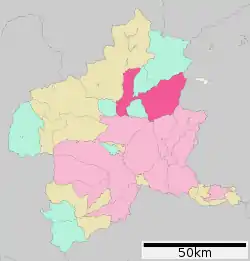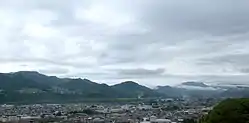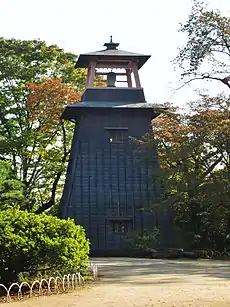Numata, Gunma
Numata (沼田市, Numata-shi) is a city located in Gunma Prefecture, Japan. As of 31 July 2020, the city had an estimated population of 46,908 in 20,589 households,[1] and a population density of 110 persons per km². The total area of the city is 443.46 square kilometres (171.22 sq mi), making it the largest city in terms of area within Gunma Prefecture. (The neighboring town of Minakami is the largest municipality in terms of area within Gunma.)
Numata
沼田市 | |
|---|---|
 Numata city hall (Terrace Numata) | |
 Flag  Emblem | |
 Location of Numata in Gunma Prefecture | |
 Numata | |
| Coordinates: 36°38′45.7″N 139°2′39″E | |
| Country | Japan |
| Region | Kantō |
| Prefecture | Gunma |
| Area | |
| • Total | 443.46 km2 (171.22 sq mi) |
| Population (July 2020) | |
| • Total | 46,908 |
| • Density | 110/km2 (270/sq mi) |
| Time zone | UTC+9 (Japan Standard Time) |
| - Tree | Sakura |
| - Flower | Chinese bellflower |
| Phone number | 0278-23-2111 |
| Address | Shimono-machi 999 , Numata-shi, Gunma-ken 378-8501 |
| Website | Official website |

Geography
Numata is located in northern Gunma Prefecture. The Tone River flows through the western part of the city and the tributary, the Katashina River, flows through the southern end, forming a large river terrace. The downtown area is located at the top of the terrace, along the Tone River.
- Mountains: Kesamaruyama (1961m), Mount Akagi (1828m)
- Rivers: Tone River, Katashina River
Surrounding municipalities
Climate
Numata has a Humid continental climate (Köppen Cfa) characterized by warm summers and cold winters with heavy snowfall. The average annual temperature in Numata is 12.0 °C. The average annual rainfall is 1522 mm with September as the wettest month. The temperatures are highest on average in August, at around 24.7 °C, and lowest in January, at around 0.1 °C.[2]
| Climate data for Numata (1981-2010) | |||||||||||||
|---|---|---|---|---|---|---|---|---|---|---|---|---|---|
| Month | Jan | Feb | Mar | Apr | May | Jun | Jul | Aug | Sep | Oct | Nov | Dec | Year |
| Record high °C (°F) | 14.9 (58.8) |
19.0 (66.2) |
24.9 (76.8) |
28.5 (83.3) |
33.5 (92.3) |
36.2 (97.2) |
37.4 (99.3) |
37.1 (98.8) |
35.8 (96.4) |
31.0 (87.8) |
23.0 (73.4) |
20.7 (69.3) |
37.4 (99.3) |
| Average high °C (°F) | 4.7 (40.5) |
5.5 (41.9) |
9.5 (49.1) |
16.4 (61.5) |
21.5 (70.7) |
24.6 (76.3) |
28.3 (82.9) |
29.9 (85.8) |
25.0 (77.0) |
19.0 (66.2) |
13.4 (56.1) |
8.0 (46.4) |
17.2 (63.0) |
| Daily mean °C (°F) | −0.3 (31.5) |
0.3 (32.5) |
3.9 (39.0) |
10.2 (50.4) |
15.4 (59.7) |
19.3 (66.7) |
23.0 (73.4) |
24.3 (75.7) |
19.9 (67.8) |
13.5 (56.3) |
7.5 (45.5) |
2.4 (36.3) |
11.6 (52.9) |
| Average low °C (°F) | −4.8 (23.4) |
−4.4 (24.1) |
−1.1 (30.0) |
4.3 (39.7) |
9.6 (49.3) |
14.7 (58.5) |
18.9 (66.0) |
20.0 (68.0) |
15.9 (60.6) |
8.9 (48.0) |
2.4 (36.3) |
−2.2 (28.0) |
6.9 (44.4) |
| Record low °C (°F) | −13.1 (8.4) |
−14.0 (6.8) |
−12.5 (9.5) |
−5.5 (22.1) |
0.0 (32.0) |
3.7 (38.7) |
10.8 (51.4) |
12.9 (55.2) |
5.3 (41.5) |
−2.2 (28.0) |
−8.7 (16.3) |
−11.1 (12.0) |
−14.0 (6.8) |
| Average precipitation mm (inches) | 37.5 (1.48) |
46.7 (1.84) |
65.6 (2.58) |
68.3 (2.69) |
93.4 (3.68) |
130.7 (5.15) |
167.6 (6.60) |
165.0 (6.50) |
169.5 (6.67) |
96.8 (3.81) |
47.2 (1.86) |
36.7 (1.44) |
1,124.9 (44.29) |
| Mean monthly sunshine hours | 167.3 | 166.7 | 192.0 | 201.8 | 200.7 | 160.3 | 170.6 | 196.7 | 142.4 | 157.2 | 167.6 | 170.1 | 2,093.4 |
| Source 1: Japan Meteorological Agency[3] | |||||||||||||
| Source 2: Japan Meteorological Agency[4] | |||||||||||||
Demographics
Per Japanese census data,[5] the population of Numata declined slightly over the past 30 years.
| Year | Pop. | ±% |
|---|---|---|
| 1920 | 37,674 | — |
| 1930 | 52,906 | +40.4% |
| 1940 | 86,086 | +62.7% |
| 1950 | 95,533 | +11.0% |
| 1960 | 56,346 | −41.0% |
| 1970 | 54,311 | −3.6% |
| 1980 | 56,828 | +4.6% |
| 1990 | 56,099 | −1.3% |
| 2000 | 55,278 | −1.5% |
| 2010 | 51,310 | −7.2% |
History
Numata developed during the Sengoku period as a castle town surrounding Numata Castle, a stronghold in Kōzuke Province contested by the Uesugi, Takeda, Later Hōjō and Sanada clans. During the Edo period, the area of present-day Numata was the center of the Numata Domain, a 35,000 koku feudal domain held by then Toki clan under the Tokugawa shogunate.
Numata Town was created within Tone District, Gunma Prefecture on April 1, 1889 with the creation of the modern municipalities system after the Meiji Restoration. On March 1, 1954, Numata merged with neighboring Tonami, Ikeda, Usune and Kawada villages, and was raised to city status. On February 13 2005 the villages of Shirasawa and Tone were incorporated into Numata. [6]
Government
Numata has a mayor-council form of government with a directly elected mayor and a unicameral city council of 20 members. Numata contributes one member to the Gunma Prefectural Assembly. In terms of national politics, the city is part of Gunma 1st district of the lower house of the Diet of Japan.
Economy
Numata is a regional commercial center and transportation hub, but was traditionally known for lumber production.
Education
Numata has 12 public elementary schools and nine public middle schools operated by the city government, and four public high schools operated by the Gunma Prefectural Board of Education. The prefecture also operates a special education school for the handicapped.
Elementary schools
- Numata Elementary School
- Numata Higashi Elementary School
- Numata Kita Elementary School
- Masugata Elementary School
- Tonami Higashi Elementary School
- Ikeda Elementary School
- Usune Elementary School
- Kawada Elementary School
- Shirasawa Elementary School
- Tone Azuma Elementary School
- Hiragawa Elementary School
- Tone Nishi Elementary School
- Tana Elementary School
Middle schools
Transportation
Railway
Highway
Local attractions

- Site of Numata Castle
- Fukiware Falls, National Place of Scenic Beauty and Natural Monument; One of Japan’s Top 100 Waterfalls
- Oigami Onsen
- Tambara Ski Park
- Tamahara Dam
Sister-city relations
 Shimoda, Shizuoka, Japan, since May 1966
Shimoda, Shizuoka, Japan, since May 1966.svg.png.webp) Port Hardy, British Columbia, Canada since September 1994[7]
Port Hardy, British Columbia, Canada since September 1994[7] Füssen, Bavaria, Germany since September 1995
Füssen, Bavaria, Germany since September 1995
Notable people
- Koji Omi, politician
- Tochiakagi Takanori, sumo wrestler
References
- "Numata City official statistics" (in Japanese). Japan.
- Numata climate data
- "沼田 1981-2010年". Japan Meteorological Agency. Retrieved August 20, 2017.
- "沼田 観測史上1~10位の値". Japan Meteorological Agency. Retrieved August 20, 2017.
- Numata population statistics
- "The Outline of City Numata". Archived from the original on 2006-10-05. Retrieved 2006-12-22.
- "Port Hardy Twinning History". Retrieved 10 January 2021.
External links
![]() Media related to Numata, Gunma at Wikimedia Commons
Media related to Numata, Gunma at Wikimedia Commons
 Numata travel guide from Wikivoyage
Numata travel guide from Wikivoyage- Official Website (in Japanese)